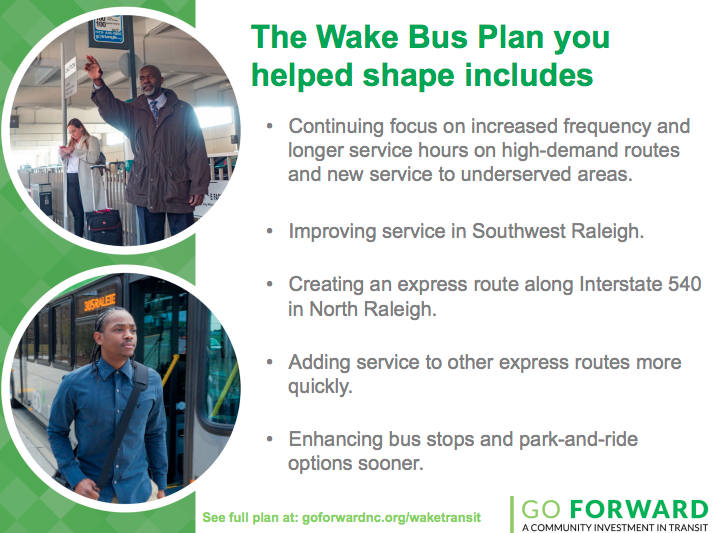 Research Triangle Park, NC (Aug. 20, 2018) – When asked in the spring to comment on the blueprints for phasing in more improvements in Wake County’s bus network through 2027, residents and riders had a few suggestions.
Research Triangle Park, NC (Aug. 20, 2018) – When asked in the spring to comment on the blueprints for phasing in more improvements in Wake County’s bus network through 2027, residents and riders had a few suggestions.
They wanted improved service in Southwest Raleigh, an express route along Interstate 540 in North Raleigh, earlier enhancements in other express routes and better bus stops and park-and-ride options.
They got them.
Based on public feedback, transit planners have revised the first phase of the Wake Bus Plan through 2024, and now the enhanced plans are available to review online here through September. In addition, residents will have four chances to drop in at meetings to see the plans and talk with transit planners, who also will be available at several public events throughout September.
The bus network expansion is the result of Wake County voters saying yes to a community investment in transit in 2016, and an important part of the 10-year Wake Transit Plan is giving the public many chances to shape how and when improvements are made.
Already, the first two years of the Wake Transit Plan have brought more frequent bus routes, longer service hours and improved bus stops that have made life easier and opportunities more accessible for many of our neighbors.
Improvements for fiscal year 2019, which started Aug. 1, have begun rolling out. GoTriangle already has added trips to its popular Raleigh-Durham express route. Other coming highlights include a high-frequency GoRaleigh route along Martin Luther King Jr. Boulevard and a GoCary route serving Weston Parkway, a large employment corridor, and Park West Village, a popular shopping destination.
Fiscal year 2020, which begins in August 2019, also has many exciting improvements in store:
- Holly Springs and Rolesville will get new express routes to transfer centers.
- Knightdale will get all-day service to the new East Raleigh Transit Center transfer station.
- Morrisville’s service also will expand to serve a new Wake Tech campus in Research Triangle Park.
In the spring, residents were asked to comment on plans for two more phases of bus network improvements – one from 2021 to 2024 and one from 2025 to 2027 – and planners have revised the plans through 2024. The public can review them at these drop-in meetings:
Aug. 21, 2018 | 5:30 – 7:30 p.m.
Laurel Hills Community Center
3808 Edwards Mill Road, Raleigh, NC 27612
Aug. 28, 2018 | 5:30 – 7:30 p.m.
Tarboro Road Community Center
121 N Tarboro St, Raleigh, NC 27610
Aug. 29, 2018 | 5:30 – 7:30 p.m.
Cary Arts Center Paul Cooper Room
101 Dry Ave, Cary, NC 27511
Sept. 4, 2018
7 – 9 a.m. | 11 a.m. – 2 p.m. | 5:30 – 7:30 p.m.
GoRaleigh Operations Center
4104 Poole Road, Raleigh, NC 27602
Or look for transit representatives at community events through September. Follow us on Twitter @waketransit to find out where.
View this PowerPoint presentation and video for a timeline of how transit improvements are being phased in.
The Wake Transit Plan is part of a larger effort to build a strong regional transit network connecting Wake, Orange and Durham counties. Orange and Durham counties also have approved transit-designated money and long-range transit plans in recent years.
Over the next decade, the Wake Transit Plan will:
- Add a network of more than 80 miles of service that runs every 15 minutes or less.
- Create 20 miles of bus rapid transit infrastructure in some highly congested corridors of Wake County. BRT uses dedicated bus lanes to bypass traffic and stations with raised platforms so passengers with wheelchairs, strollers or bicycles can more easily board buses.
- Build a 37-mile commuter rail transit system from Garner through Raleigh, N.C. State University, Cary, Morrisville and Research Triangle Park to Durham.